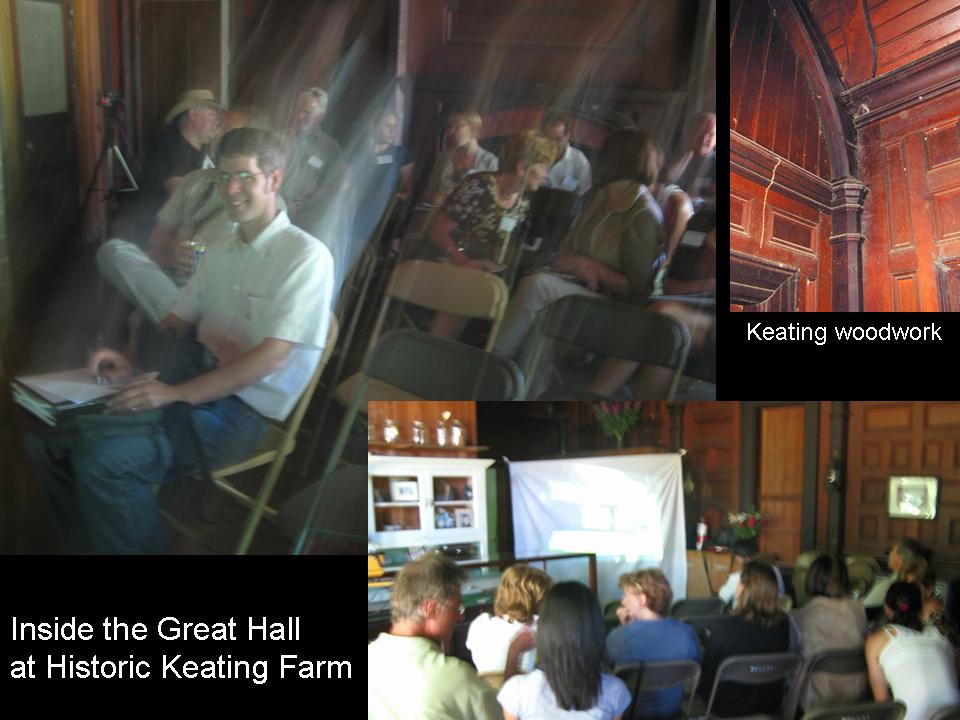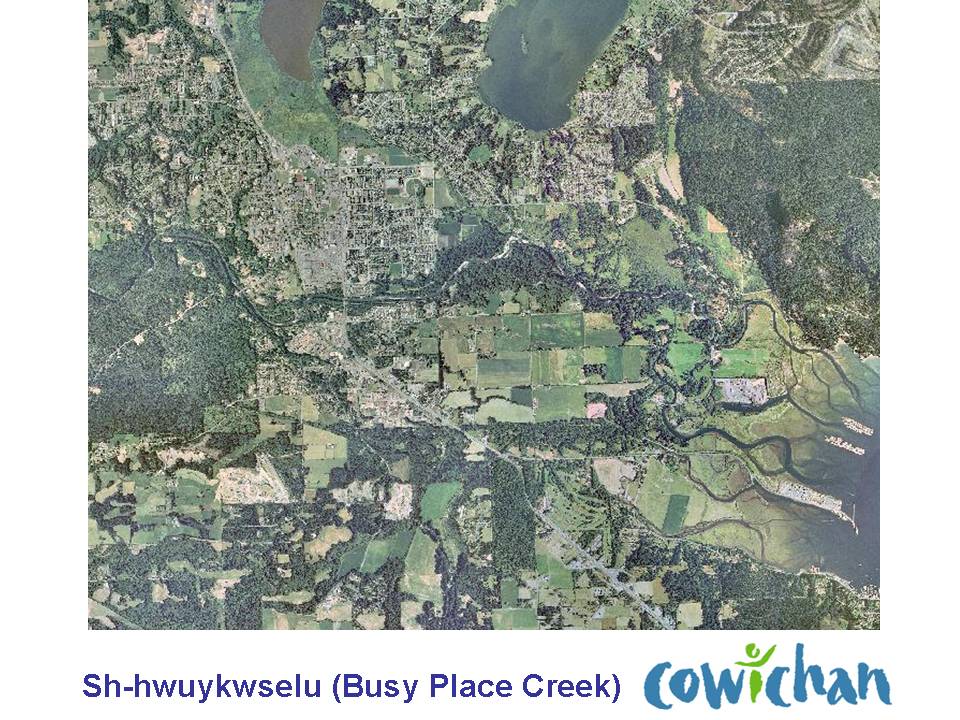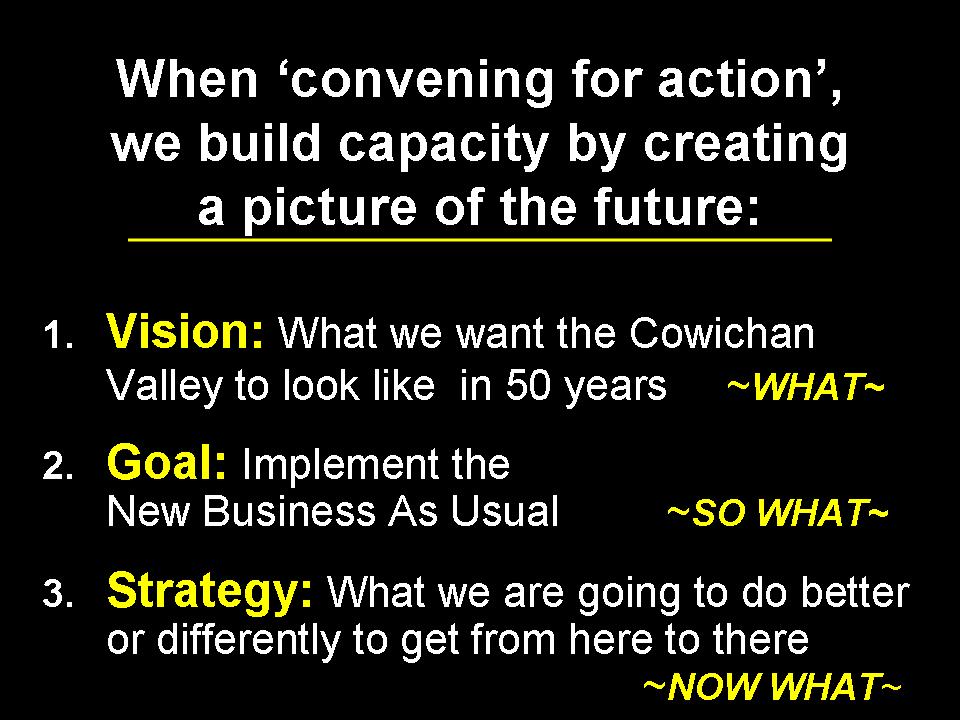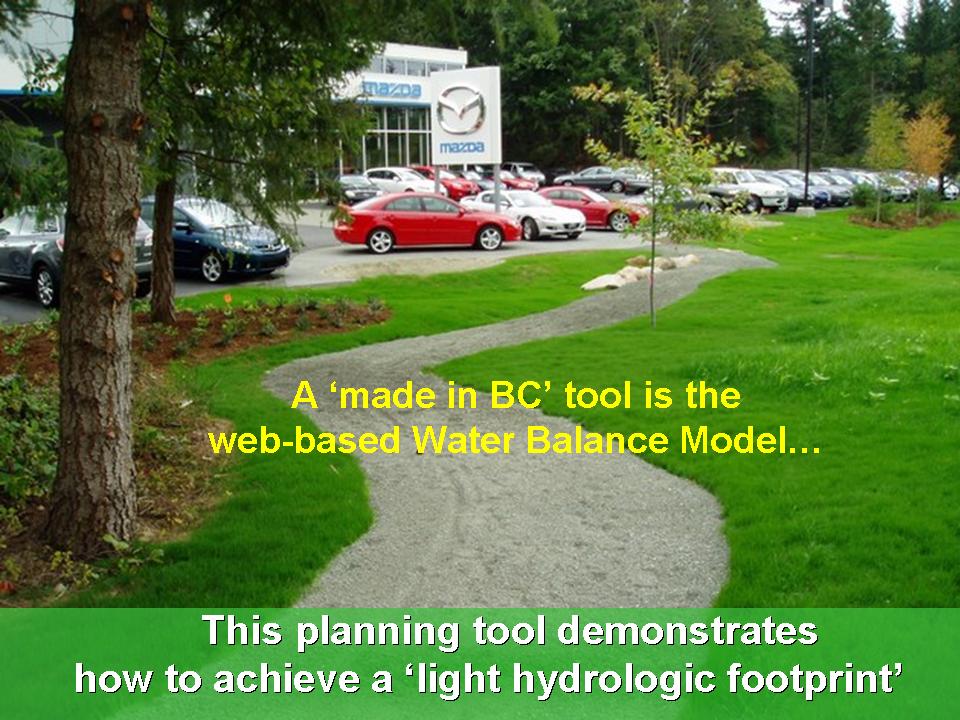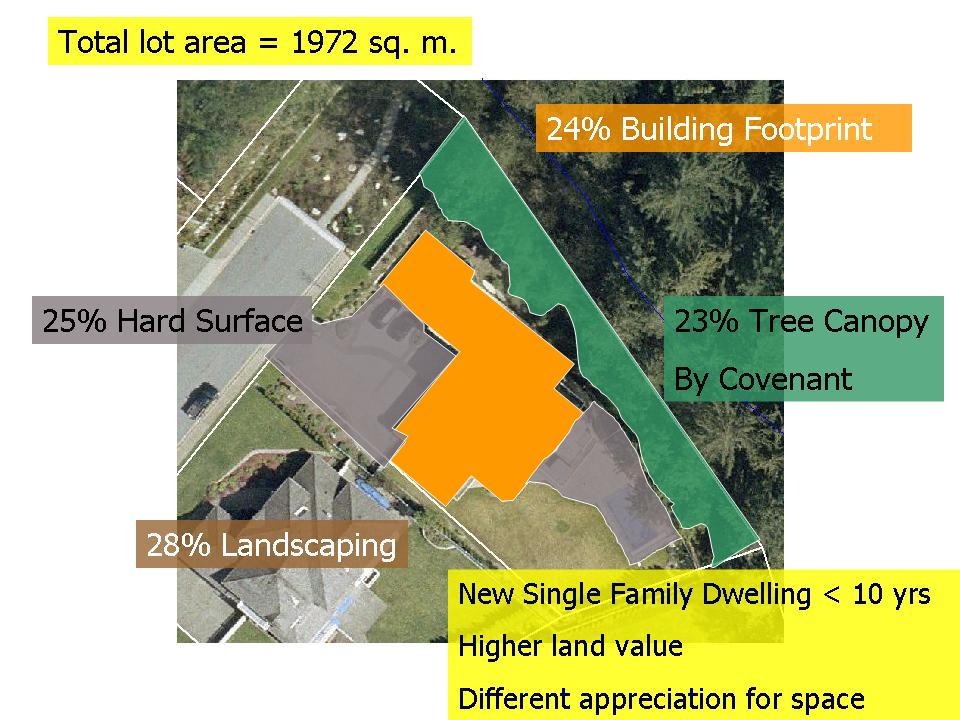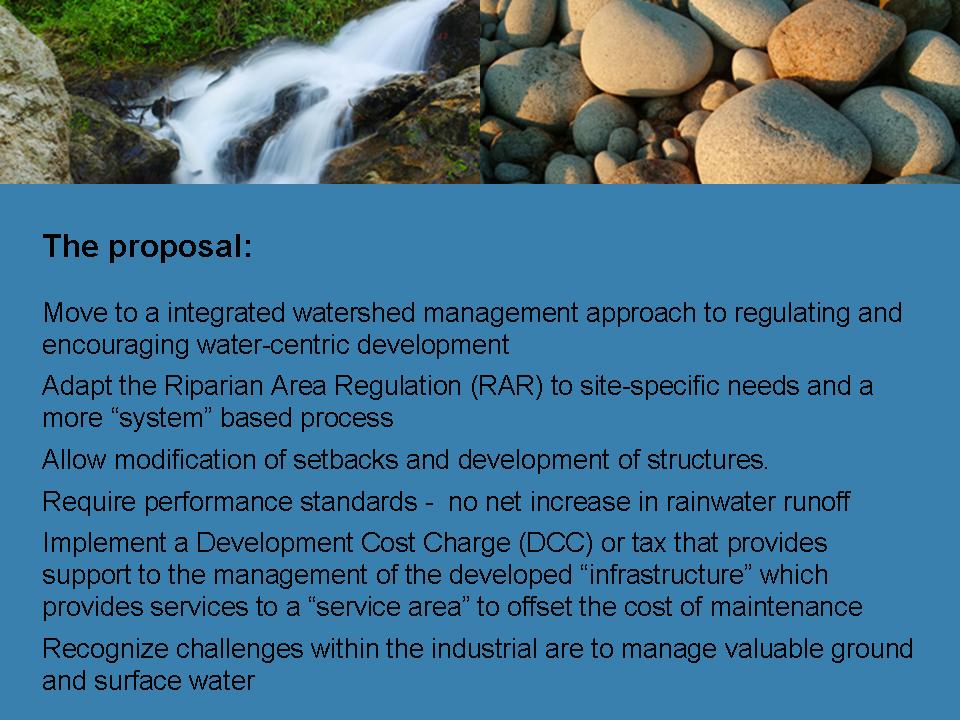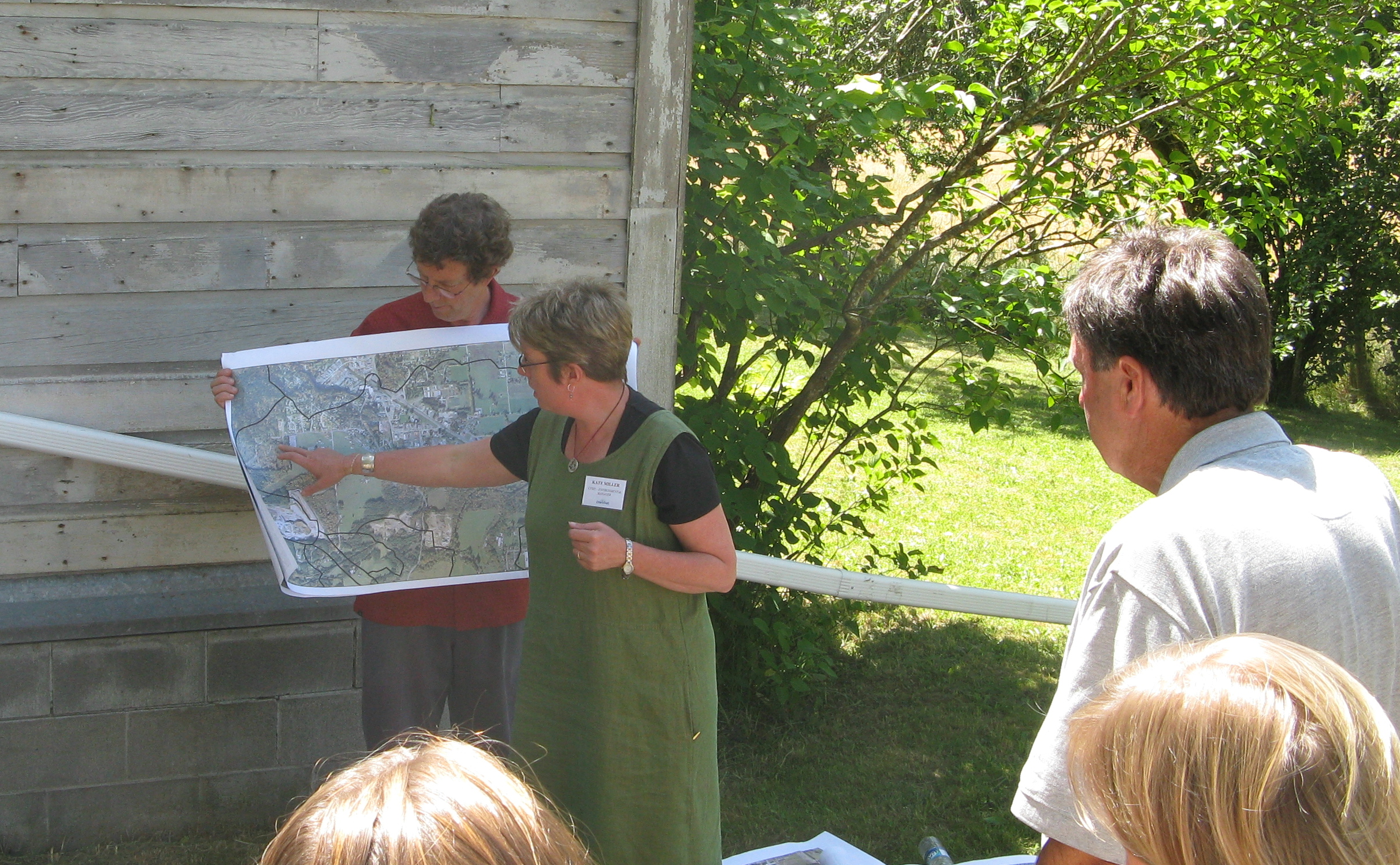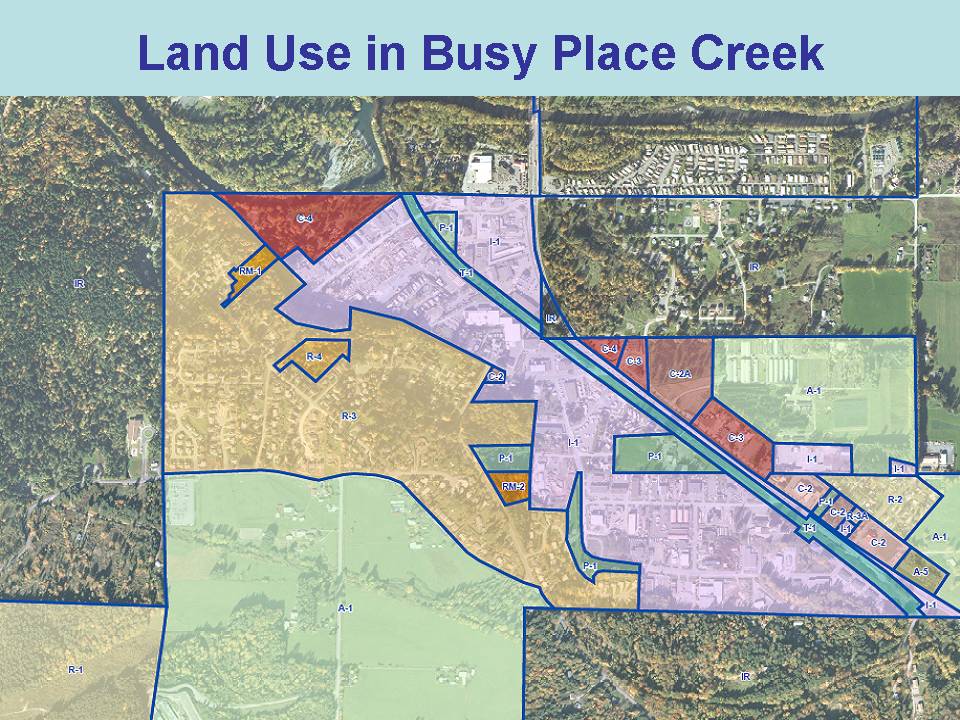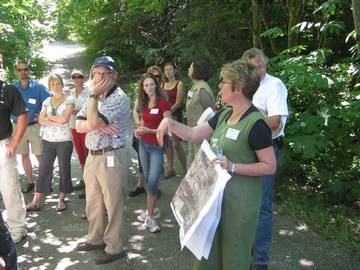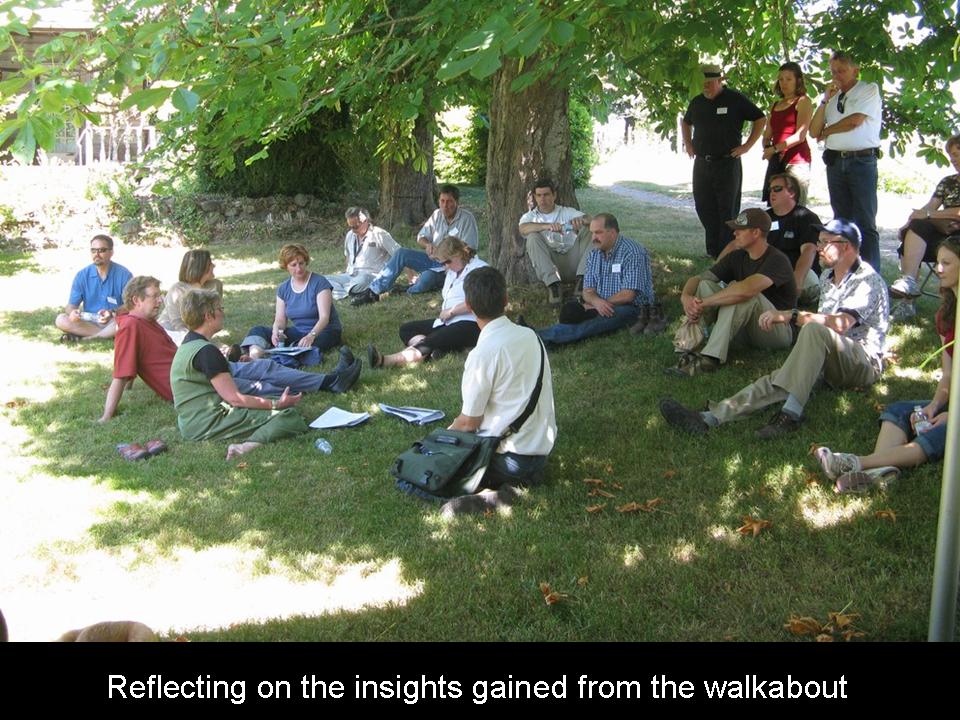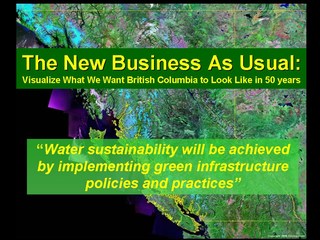Cowichan Valley Learning Lunch Seminar #3 – focus on watershed targets for protecting stream health
Walkabout through Busy Place Creek drainage area helps pull concepts together for local government participants
The Learning Lunch Seminar Series is a precedent-setting approach to continuing education for local government practitioners; and is the first step in building a regional team approach so that there will be a common understanding and consistent messaging in the Cowichan Valley regarding on-the-ground expectations for rainwater management and green infrastructure. The Cowichan Valley Learning Lunch Seminar Series comprised a set of three sessions held during the June-July 2008 period.
Historic Keating Farm: Venue for Seminar #3
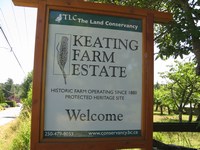 “We held the third Cowichan Valley seminar at the Great Hall at the Historic Keating Farm to provide a change of pace and to dedicate the afternoon segment to a walkabout in the surrounding Busy Place Creek drainage basin,” reports Kate Miller, Environmental Manager for the Cowichan Valley Regional District and Chair of the seminar organizing committee.
“We held the third Cowichan Valley seminar at the Great Hall at the Historic Keating Farm to provide a change of pace and to dedicate the afternoon segment to a walkabout in the surrounding Busy Place Creek drainage basin,” reports Kate Miller, Environmental Manager for the Cowichan Valley Regional District and Chair of the seminar organizing committee.
The most important of the heritage buildings on the farm is the main house, which was built in three stages. It started out as a small farm house, which was doubled in size, probably in 1888, when new owner Andrew Keating purchased the property. In 1894, Keating commissioned architect John Gerhard Tiarks to enlarge and rebuild the farmhouse. Tiarks  designed a huge addition in the form of a Great Hall, which was built behind the farmhouse on the North side. This Hall, about 35 feet long and 25 feet wide, has a vaulted ceiling supported by carved beams that arch across the Hall. The Hall is intricately panelled and built entirely of first growth fir and cedar which retains its original 1894 finish.
designed a huge addition in the form of a Great Hall, which was built behind the farmhouse on the North side. This Hall, about 35 feet long and 25 feet wide, has a vaulted ceiling supported by carved beams that arch across the Hall. The Hall is intricately panelled and built entirely of first growth fir and cedar which retains its original 1894 finish.
Busy Place Creek:
 According to Kate Miller, “This area of mixed land uses is a microcosm of the challenges and opportunities characteristic of the Cowichan Valley. As such, it provides an abundance of challenges and lessons learned. Teachable moments during the walkabout illustrated how upstream actions have downstream consequences.”
According to Kate Miller, “This area of mixed land uses is a microcosm of the challenges and opportunities characteristic of the Cowichan Valley. As such, it provides an abundance of challenges and lessons learned. Teachable moments during the walkabout illustrated how upstream actions have downstream consequences.”
 “By holding the seminar in the heart of the Busy Place Creek drainage area, this introduced an on-the-ground reality to the topic of performance targets,” adds Kim Stephens, team leader and Program Coordinator for the Water Sustainability Action Plan for British Columbia. ” We wanted to show participants why a performance target approach to land development makes sense, can meet multiple objectives, and thereby result in net environmental benefits at a watershed scale.
“By holding the seminar in the heart of the Busy Place Creek drainage area, this introduced an on-the-ground reality to the topic of performance targets,” adds Kim Stephens, team leader and Program Coordinator for the Water Sustainability Action Plan for British Columbia. ” We wanted to show participants why a performance target approach to land development makes sense, can meet multiple objectives, and thereby result in net environmental benefits at a watershed scale.
Series Recap & Reflection
Kim Stephens opened the seminar by recapping the first two seminars and reflecting on the learning outcomes for each session. “Because we have deluged participants with information in the course of the series, the organizing committee concluded that we needed to step back and articulate clear take-away messages,”  he explained. “So, we identified a defining or over-arching message for each seminar by coming up with a memorable sound-bite; and we also synthesized three learning outcomes for each seminar.” To view a 9-minute video clip of Kim Stephens putting the series in context, click here on the adjacent image.
he explained. “So, we identified a defining or over-arching message for each seminar by coming up with a memorable sound-bite; and we also synthesized three learning outcomes for each seminar.” To view a 9-minute video clip of Kim Stephens putting the series in context, click here on the adjacent image.
According to Rob Conway, (Assistant Manager, Development Services, Cowichan Valley Regional District): “We wanted to make it easy for participants to remember what 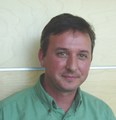 they heard and why this is relevant to their day jobs. When we reflected on Seminar #2, for example, we decided that a statement by Susan Rutherford captured the storyline for the day: The risk is in carrying on with the Old Business As Usual. The organizing committee anticipates that these sound-bites will serve as prompts to encourage participants to review the reference materials.”
they heard and why this is relevant to their day jobs. When we reflected on Seminar #2, for example, we decided that a statement by Susan Rutherford captured the storyline for the day: The risk is in carrying on with the Old Business As Usual. The organizing committee anticipates that these sound-bites will serve as prompts to encourage participants to review the reference materials.”
To download the PowerPoint slides by Kim Stephens that contain this synopsis, click on this link to defining messages and learning outcomes for the Cowichan Valley Learning Lunch Seminar Series. By listening to the audio for the video clip (see instruction above) while viewing the slides, this should provide a reasonable impression of what was said by Kim Stephens, and in what context.
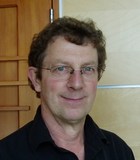 “Throughout the series, our theme and our challenge has been to ask participants what will everyone do better or differently to achieve a shared vision for the Cowichan Valley,” added David Hewetson (Building Inspector, City of Duncan). “This is why it was so important to get everyone thinking in terms of the What – So What – Now What mind-map.” The process for moving from a vision to implementation of a strategy is captured in the graphic below. The goal is to implement the New Business As Usual.
“Throughout the series, our theme and our challenge has been to ask participants what will everyone do better or differently to achieve a shared vision for the Cowichan Valley,” added David Hewetson (Building Inspector, City of Duncan). “This is why it was so important to get everyone thinking in terms of the What – So What – Now What mind-map.” The process for moving from a vision to implementation of a strategy is captured in the graphic below. The goal is to implement the New Business As Usual.
A Common Understanding Starts with a Conversation
The emphasis in Seminar #3 was on creating opportunities for conversations because conversations lead to dialogue, and dialogue ultimately leads to consensus. For this reason, and after the opening segment, participants reconvened outdoors for a group discussion in the sunshine.
Roles individuals can play
“The Learning Lunch Seminar Series is a pilot program,” Kate Miller reminded everyone in setting the context for group reflection. “We have started a dialogue with regional technical staff…planning, engineering, building inspection and others….so that we can reach  consensus on how this region will move forward with implementation of the New Business As Usual. Looking ahead to what we hope to accomplish this Fall when we organize a Water Balance Model Forum, we need to go to the next step regarding how to communicate with the development community and the public about what rainwater management and green infrastructure mean on the ground…in the Cowichan Valley. For this reason, everyone participating in the seminar series needs to be thinking about what role YOU can play in developing rainwater management policy in your organization or your constituency.”
consensus on how this region will move forward with implementation of the New Business As Usual. Looking ahead to what we hope to accomplish this Fall when we organize a Water Balance Model Forum, we need to go to the next step regarding how to communicate with the development community and the public about what rainwater management and green infrastructure mean on the ground…in the Cowichan Valley. For this reason, everyone participating in the seminar series needs to be thinking about what role YOU can play in developing rainwater management policy in your organization or your constituency.”
Consistency at the front counter
 “Having the discussion outdoors in the sunshine worked well,” observed Kim Stephens. “The discussion was spontaneous and each person who spoke built on the comments and/or observations of the person who spoke before them. What became clear very quickly about the value of the Learning Lunch Seminar Series is that it helps local government representatives conceptualize why a consistent approach is needed and what it means regionally.”
“Having the discussion outdoors in the sunshine worked well,” observed Kim Stephens. “The discussion was spontaneous and each person who spoke built on the comments and/or observations of the person who spoke before them. What became clear very quickly about the value of the Learning Lunch Seminar Series is that it helps local government representatives conceptualize why a consistent approach is needed and what it means regionally.”
“Within the Cowichan Valley Regional District, there are five local government jurisdictions; and the same group of developers and development consultants have projects in all or most of those jurisdictions,” 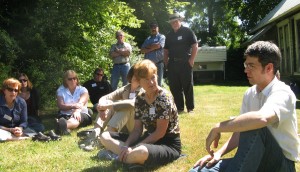 summarized Peter Nilsen (Deputy Engineer, District of North Cowichan). “It therefore becomes essential that developers and their consultants hear a consistent message regarding rainwater management and green infrastructure expectations when doing business at the front counters in each of those jurisdictions.”
summarized Peter Nilsen (Deputy Engineer, District of North Cowichan). “It therefore becomes essential that developers and their consultants hear a consistent message regarding rainwater management and green infrastructure expectations when doing business at the front counters in each of those jurisdictions.”
Mayor Phil Kent of Duncan expressed the importance of providing consistent and clear goal posts when it comes to managing rain water. He noted that there are sophisticated 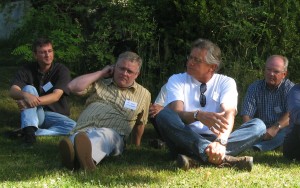 and savvy developers who have the resources and expertise to accommodate new techniques and approaches; however, many customers just want help to get their building permits or projects approved and may get frustrated with too much perceived bureaucracy.
and savvy developers who have the resources and expertise to accommodate new techniques and approaches; however, many customers just want help to get their building permits or projects approved and may get frustrated with too much perceived bureaucracy.
Jay Bradley, Chair of the Vancouver Island Coordinating Team (VICT), indicated that this  is one of the key benefits of the Water Balance Model – it provides the user with easibly accessible and understandable targets that reflect the individual characteristics of a site. “The ability to formulate targets and to graphically visualise the effects of source controls on surface runoff means anyone can use the tool, and the consistency and certainty of outcomes can help local government’s make decisions that are transparent and defensible,” commented Jay Bradley.
is one of the key benefits of the Water Balance Model – it provides the user with easibly accessible and understandable targets that reflect the individual characteristics of a site. “The ability to formulate targets and to graphically visualise the effects of source controls on surface runoff means anyone can use the tool, and the consistency and certainty of outcomes can help local government’s make decisions that are transparent and defensible,” commented Jay Bradley.
“By bringing everyone together in a seminar setting, this learning experience provides us with the same starting point,” concluded David Hewetson. “We hear first-hand what 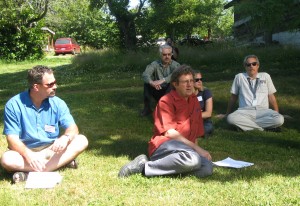 was in the minds of the authors when they wrote the Stormwater Guidebook, the Green Infrastructure Guide, and Develop with Care. This then provides us with focus regarding a performance-based approach that will achieve the desired outcome…which is to ensure that our communities are liveable and we protect stream health.”
was in the minds of the authors when they wrote the Stormwater Guidebook, the Green Infrastructure Guide, and Develop with Care. This then provides us with focus regarding a performance-based approach that will achieve the desired outcome…which is to ensure that our communities are liveable and we protect stream health.”
Performance Targets
Founded on British Columbia case study experience, and published by the Province in 2002, Stormwater Planning: A Guidebook for British Columbia formalized a science-based understanding to set performance targets for reducing rainwater runoff volumes and rates. These targets represent the synthesis of biological and hydrological understanding.
 Kim Stephens explained the thinking behind the use of performance targets. “Once we went back to basics and developed the concept of a Rainfall Spectrum, this then led into the concept of Performance Targets for rainwater runoff capture,” he stated. “The reason runoff percentage is the performance target is that municipalities exert control over runoff volume through their land development and infrastructure policies, practices and actions.”
Kim Stephens explained the thinking behind the use of performance targets. “Once we went back to basics and developed the concept of a Rainfall Spectrum, this then led into the concept of Performance Targets for rainwater runoff capture,” he stated. “The reason runoff percentage is the performance target is that municipalities exert control over runoff volume through their land development and infrastructure policies, practices and actions.”
To gain an appreciation for the Performance Target approach, view the set of PowerPoint slides presented by Kim Stephens while at the same time listening to the audio portion of a video clip of him elaborating on each slide. To access the video clip, click here or on the image below.
Water Balance Model
Developed by an Inter-Governmental Partnership, the Water Balance Model powered by QUALHYMO is a public domain, on-line decision support and scenario modeling tool for promoting rainwater management and stream health protection through implementation of “green” development practices. The appeal and the strength of the tool is that it is evolving to meet the “needs and wants” of participating agencies.
First, Kim Stephens explained how the “original Water Balance Model” was applied at the site scale. Then he explained where British Columbia is going with the “new Water Balance Model” at the watershed scale. To download a copy of his presentation, click on An Introduction to the Water Balance Model.
Application at the Site Scale
Initially, the WBM was a planning tool that had a site focus. It enabled users to evaluate the effectiveness of source controls — such as absorbent landscaping, infiltration facilities, green roofs, and rainwater harvesting — in achieving performance targets for rainwater volume capture and runoff rate control under various combinations of land use, soil and climate conditions.
To illustrate how the Water Balance Model supports informed decision-making, Kim Stephens presented a comparison of 1950s versus 1990s development footprints. “Richard Boase of the District of North Vancouver developed the comparison to show why changes in development practices were needed in order to achieve watershed health objectives,” explained Stephens.
To gain an appreciation for the application of the Water Balance Model at a site scale, view the set of PowerPoint slides presented by Kim Stephens while at the same time listening to the audio portion of a video clip of Kim Stephens elaborating on each slide. To access the video clip, click here or on the image below.
Application at the Watershed Scale
The Water Balance Model powered by QUALHYMO was developed under the umbrella of the Water Sustainability Action Plan for British Columbia. “It is a supporting tool for Beyond the Guidebook, a provincial initiative to advance implementation of green infrastructure policies and practices”, explained Kim Stephens.
Integration of the Water Balance Model with QUALHYMO provides drainage engineers with a suite of analytical capabilities, from site to watershed. Kim Stephens told the Cowichan audience that “the over-arching goal in integrating these tools is to help local governments achieve desired urban stream health and environmental protection outcomes at a watershed scale.”
The QUALHYMO computational engine resides on the Water Balance Model server as a stand-alone tool in order to accommodate the modeling needs of advanced users.
To gain an appreciation for the application of the “new Water Balance Model” at a watershed scale, view the set of PowerPoint slides presented by Kim Stephens while at the same time listening to the audio portion of a video clip of Kim Stephens elaborating on each slide. To access the video clip, click here or on the image below.
Busy Place Creek Walkabout
The Cowichan Valley Regional District is proceeding with development of a master drainage plan for Busy Place Creek. The plan is serving as a pilot process to inform a water-centric approach to land use planning. Furthermore, the process will also inform a regional policy framework for rainwater management and green infrastructure that protects stream health.
“Busy Place Creek is a small but complex watershed that is experiencing problems, and is under development pressure. Also, there are differences in stakeholder expectations from top to bottom. This mix provides lots of opportunities for policy development,” explained Kate Miller.
“Busy Place Creek originates in a residential area, passes through an agricultural area, then finds its way through another residential area before exiting into an industrial park located in a floodplain,” continued Kate Miller. “After that, it crosses the Island Highway and discharges into the Koksilah River which flows into the Strait of Georgia.”
Below, Kate Miller describes the downstream impacts that resulted from increased flow in Busy Place Creek and a culvert failure at an access road crossing. To view a short video clip, click on the photo.
Local Examples Shape Expectations and Inform Policy
The key message flowing from the final group discussion after the walkabout was the importance of providing examples that illustrate expectations. “There are two  types of examples, good and bad,” observed Peter Nilsen.”While the bad examples allow us to state and show exactly what we don’t want, they become counter-productive. An abundance of good local examples helps accelerate the changes in standard practices. So it is essential that local government and the development community align their efforts to produce examples that show exactly what we want our communities to look like.”
types of examples, good and bad,” observed Peter Nilsen.”While the bad examples allow us to state and show exactly what we don’t want, they become counter-productive. An abundance of good local examples helps accelerate the changes in standard practices. So it is essential that local government and the development community align their efforts to produce examples that show exactly what we want our communities to look like.”
“This is precisely why we implemented the Showcasing Green Infrastructure Innovation program on both sides of the Georgia Basin,” added Kim Stephens. “Our experience is that once someone builds the first one, whatever that one may be, others will say what’s the big deal, we can do that and we can do it better.”
According to John Finnie, Chair of CAVI – Convening for Action on Vancouver Island which is responsible for both the Showcasing Innovation and Learning Lunch series: “The goal in showcasing innovation and celebrating successes is to promote networking, 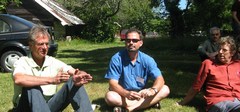 build regional capacity, and move ‘from awareness to action’ – through sharing of green infrastructure approaches, tools, experiences and lessons learned as an outcome of designing with nature.”
build regional capacity, and move ‘from awareness to action’ – through sharing of green infrastructure approaches, tools, experiences and lessons learned as an outcome of designing with nature.”
“There are a lot of good things happening throughout Vancouver Island. Yet practitioners in local government are not necessarily aware when they are being innovative and are not often aware of innovation in other municipalities,” continued John Finnie, “Because people are so busy in their own worlds, it takes a third party to connect them, just as we have done through the Learning Lunch Seminar Series. That is the role that CAVI plays.”
Series Overview
“Each session in the Learning Lunch Seminar Series started at 11:00am and ended at 2:30pm,” explains Peter Nilsen, District of North Cowichan representative on the  Cowichan Valley Organizing Committee. “Our experience is that this is the right length of time to maintain the interest and energy level of participants. Three and a half hours sounds like a lot of time, but it goes quickly; and we were just scratching the surface in terms of the material that we presented.” The theme and scope of each session are summarized below:
Cowichan Valley Organizing Committee. “Our experience is that this is the right length of time to maintain the interest and energy level of participants. Three and a half hours sounds like a lot of time, but it goes quickly; and we were just scratching the surface in terms of the material that we presented.” The theme and scope of each session are summarized below:
- Today’s Expectations are Tomorrow’s Standards: Session #1 traced the evolution of rainwater/stormwater management policies and practices over the past decade. This provided a frame-of-reference and a common understanding for subsequent sessions. To view the story of Seminar #1, click here or on the image below.
- Legal and Policy Strategies to Support Green Infrastructure: Session #2 introduced the extensive and very specific tools available under the Local Government Act so that they can proactively manage the complete spectrum of rainfall events: from light showers to heavy rain to extreme storms. To view the story of Seminar #2, click here or on the image below.
- Establishing Watershed Performance Targets: Session #3 introduced a performance target approach to land development that makes sense, meets multiple objectives, is affordable, and results in net environmental benefits at a watershed scale.
![]() “The series comprises three sessions that provide an inter-departmental learning opportunity for collaborative exploration. The series is conducted as a cumulative process, from philosophy to tools,” reports Kate Miller.
“The series comprises three sessions that provide an inter-departmental learning opportunity for collaborative exploration. The series is conducted as a cumulative process, from philosophy to tools,” reports Kate Miller.
![]() “By spreading the curriculum over three sessions, this enables participants to absorb the new information, blend it with their own experience, and eventually apply it in making decisions,” notes Kim Stephens.
“By spreading the curriculum over three sessions, this enables participants to absorb the new information, blend it with their own experience, and eventually apply it in making decisions,” notes Kim Stephens.
To Learn More:
For more detailed information on the series design, click on the following link to download a copy of the Program Outline for Learning Lunch Seminar Series.
PowerPoint Presentations: By listening to the audio for a video clip while viewing the slides, this should provide a reasonable impression of what was said, and in what context.
- Defining Messages & Learning Outcomes:
PowerPoint
Video Clip - Performance Targets:
PowerPoint
Video Clip
- Water Balance Model:
PowerPoint #1 (Site Scale)
Video Clip #1PowerPoint #2 (Watershed Scale)
Video Clip #2



